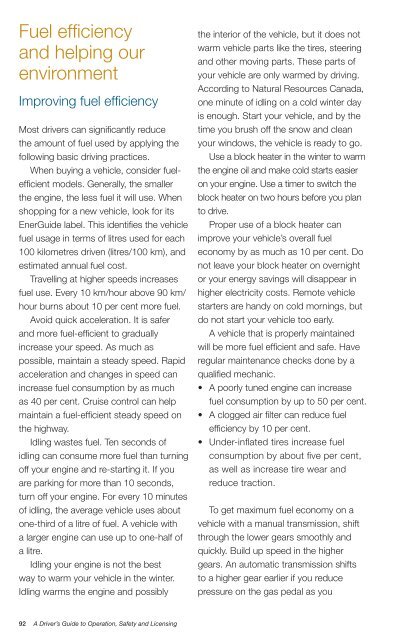DRIVER’S GUIDE
1POl7Ob
1POl7Ob
Create successful ePaper yourself
Turn your PDF publications into a flip-book with our unique Google optimized e-Paper software.
Fuel efficiency<br />
and helping our<br />
environment<br />
Improving fuel efficiency<br />
Most drivers can significantly reduce<br />
the amount of fuel used by applying the<br />
following basic driving practices.<br />
When buying a vehicle, consider fuelefficient<br />
models. Generally, the smaller<br />
the engine, the less fuel it will use. When<br />
shopping for a new vehicle, look for its<br />
EnerGuide label. This identifies the vehicle<br />
fuel usage in terms of litres used for each<br />
100 kilometres driven (litres/100 km), and<br />
estimated annual fuel cost.<br />
Travelling at higher speeds increases<br />
fuel use. Every 10 km/hour above 90 km/<br />
hour burns about 10 per cent more fuel.<br />
Avoid quick acceleration. It is safer<br />
and more fuel-efficient to gradually<br />
increase your speed. As much as<br />
possible, maintain a steady speed. Rapid<br />
acceleration and changes in speed can<br />
increase fuel consumption by as much<br />
as 40 per cent. Cruise control can help<br />
maintain a fuel-efficient steady speed on<br />
the highway.<br />
Idling wastes fuel. Ten seconds of<br />
idling can consume more fuel than turning<br />
off your engine and re-starting it. If you<br />
are parking for more than 10 seconds,<br />
turn off your engine. For every 10 minutes<br />
of idling, the average vehicle uses about<br />
one-third of a litre of fuel. A vehicle with<br />
a larger engine can use up to one-half of<br />
a litre.<br />
Idling your engine is not the best<br />
way to warm your vehicle in the winter.<br />
Idling warms the engine and possibly<br />
the interior of the vehicle, but it does not<br />
warm vehicle parts like the tires, steering<br />
and other moving parts. These parts of<br />
your vehicle are only warmed by driving.<br />
According to Natural Resources Canada,<br />
one minute of idling on a cold winter day<br />
is enough. Start your vehicle, and by the<br />
time you brush off the snow and clean<br />
your windows, the vehicle is ready to go.<br />
Use a block heater in the winter to warm<br />
the engine oil and make cold starts easier<br />
on your engine. Use a timer to switch the<br />
block heater on two hours before you plan<br />
to drive.<br />
Proper use of a block heater can<br />
improve your vehicle’s overall fuel<br />
economy by as much as 10 per cent. Do<br />
not leave your block heater on overnight<br />
or your energy savings will disappear in<br />
higher electricity costs. Remote vehicle<br />
starters are handy on cold mornings, but<br />
do not start your vehicle too early.<br />
A vehicle that is properly maintained<br />
will be more fuel efficient and safe. Have<br />
regular maintenance checks done by a<br />
qualified mechanic.<br />
• A poorly tuned engine can increase<br />
fuel consumption by up to 50 per cent.<br />
• A clogged air filter can reduce fuel<br />
efficiency by 10 per cent.<br />
• Under-inflated tires increase fuel<br />
consumption by about five per cent,<br />
as well as increase tire wear and<br />
reduce traction.<br />
To get maximum fuel economy on a<br />
vehicle with a manual transmission, shift<br />
through the lower gears smoothly and<br />
quickly. Build up speed in the higher<br />
gears. An automatic transmission shifts<br />
to a higher gear earlier if you reduce<br />
pressure on the gas pedal as you<br />
92 A Driver’s Guide to Operation, Safety and Licensing


